
Fritz
Member+-
Posts
224 -
Joined
-
Last visited
-
Days Won
2
Everything posted by Fritz
-
Thanks. Do you know if this dimmer is compatible with the LED lights used on more recent trailers? I recall (hopefully incorrectly) that LEDs used in 2021 trailers are not dimmable. It would be great to be able to dim some of the interior touch lights and exterior lights.
-
So far I've only tried the dark film in the driveway, but it seems there is plenty of functional light. From a distance, the "bright-in-your-face" light from a distance (i.e., neighboring campsite) is substantially diminished. The awning light on more recent trailers is available for more street-side light if needed. Finally, the film can be removed if you feel it's too dark. I did try film on only half of the light next to the door (see photo), thinking this would leave more light around the door but diminish the distance brightness. However, the light still seemed to bright at a distance, so I removed the film and replaced it with a full-coverage piece. I found the best way to apply the film was to place a piece of masking tape over the light, carefully trim with a precision hobby knife the portion of the masking tape covering the chrome housing. The remaining portion of masking tape covering the lens can then be removed and used as a template for cutting the film.
-
Similarly, I added a dark tinted film. Subdues the patio lights, which really should be switchable by side. https://www.amazon.com/gp/product/B017MWRQY6/ref=ppx_yo_dt_b_search_asin_title?ie=UTF8&psc=1
-
The pictures did not come on my post above (ugh!). Here is another try. You'll just have to imagine that the photos are appropriately placed with relevant text.
-
I, like others, mounted the Levelmate in the closet, because it is about halfway between the driver’s seat in the tow vehicle and the stabilizer switches in the rear of the trailer (I've found that signal strength is generally fine with this location). The Levelmate is installed with 3M Command velcro strips. Secure, no screw holes, removable. It’s easy enough to reach into the closet and turn the Levelmate on. But the batteries are rather short-lived, so I would run back to the trailer and turn it on prior to parking (and leveling). Problem is, it is too easy (at least for me) to forget to turn off the Levelmate. Result: dead battery, yet again. So I decided to hard-wire the unit. Theoretically the unit could be wired directly to the trailer’s 12V system, but I used the USB cable that came with the Levelmate instead. This requires an accessible USB charger; the closest existing USB charger was too far away. Thus, wiring the Levelmate consisted of installing a USB charger within a cable-length of the Levemate unit. As there was no really good location in the closet (criteria being a wall with accessible space behind), I installed it in the galley cabinet (referred to hereafter simply as “cabinet”) above the microwave cabinet. I also wanted the Levelmate on easily for driving (so that it is ready to use when I want to park), but off when not driving or parking. So I connected the Levelmate to the same circuit as the rear camera. On when driving, off when parked. The Levelmate draws very little current (or the 2032 or 2050 batteries in the Levelmate, depending on model, would be insufficient), so I was not very concerned about overloading the camera circuit. There are many (and probably some better) ways of wiring the Levelmate, but here’s what I did: 1. I began by removing the screws securing the main Oliver switch panel to the wall (giving access to the wires behind it) and the port cover in the cabinet. 2. The rear camera switch has 3 wires attached: 2 tan wires and one yellow wire. In my trailer (2021 LE2), the bottom tan wire is continuous 12V, the middle tan wire is 12V only when the camera switch is on, and the yellow wire is ground. I verified this with a circuit tester, using metal in the exterior lower refrigerator vent as a ground. (It would be SO GOOD to have an electrical diagram for the trailer!) 3. I removed the closet light, and used a 36” zip tie (3/8” width) to fish between the closet-light hole and the cabinet port. I tried fishing with 2 different wires (which were either too stiff and it would get stuck, or to thin and would bend); the zip tie was sufficiently stiff yet flexible, and I could work it though without getting caught on reflectix insulation. 4. Once I confirmed my ability to fish, I drilled a 1 1/8” hole in a part of the cabinet that did not have wires behind it, and another hole for the USB cable (3/8”, I think). Similarly, I drilled a hole in the closet (1/2”, I think) for the other end of the USB cable. The hole sizes for the cable are different because the cable ends are different sizes. 5. I taped the small end of the USB cable to the zip tie, and pulled it from the closet to the cabinet. I placed a rubber grommet in the smaller hole, and a rubber bushing in the larger fiberglass hole, to protect the cable from chafing in the fiberglass holes. In both cases, I cut the grommet and bushing on a bandsaw to slip them over the cable. 6. I then spliced the tan middle tan wire on the camera switch with a quick-splice snap-wire connector, to which I connected a shrouded spade connector attached to about 10” of 16 ga wire, which in turn got connected with a shrouded connector to the positive terminal of a Blue Sea 2.1A USB charger (https://www.amazon.com/Blue-Sea-Systems-Charger-Socket/dp/B0082CXEI8/ref=sr_1_1?crid=3QD4BPGGKK7GE&keywords=blue%2Bsea%2B2.1%2Busb&qid=1685469544&sprefix=blue%2Bsea%2B2.1%2Busb%2Caps%2C196&sr=8-1&th=1). There are cheaper charging ports available, but the others in the trailer are this brand, and Blue Sea previously responded quickly when a charging port in the trailer failed. The negative charger terminal was similarly spliced to the yellow wire on the switch. In conclusion, I’m happy with this solution to a first-world problem—it lets me use the Levelmate app when pulling (or backing) into a site without having to first run back and turn the Levelmate unit on.
-
Previous post incomplete; will post how-to on wiring levelmate shortly....
-
Mike, could you (or others that have installed this or a similar box) perhaps send some photos of how you attached it to the trailer frame? If doing it again, might you do it differently? Thanks!
-
To get a decent discharge I think it's necessary to turn off the solar controller (the switch located in the storage area above the streetside bed). This prevents incidental recharge.
-
Have you ever removed the toilet for cleaning and removed the fan in the process? The interior connection between wire and fan (i.e., the fan connection closest to the business portion of the toilet), in my experience, is prone to corrosion and is sensitive to movement when removing for cleaning. Perhaps not the first place to look, but something to keep in mind.
-
Lithionics Lithium Batteries; RVC or LVC state-of charge status?
Fritz replied to Gliddenwoods's topic in Delivery Day Photos
I don’t know… But you might begin by checking the voltage in each battery with the Lithionics app. In my experience, the voltage recovers somewhat after the load has stopped. This might tell you if the battery voltages are in the LVC or RVC range. -
Hull #1291 Delivery, Inspection and Warranty Service Report
Fritz replied to Rivernerd's topic in Mechanical & Technical Tips
My understanding from two tire shops in Boise is that the ST tires are designed, in part, for the tire “scrubbing” that occurs when making tight turns with a two-axle trailer. That said, one of the shops (Les Schwab) said they sell many LT tires for trailer applications. Unless necessary, I try to avoid excessively tight turns to reduce scrubbing. -
-
The Zarcor shade does not slide up-down like the other Oliver shades. The Zarcor shade consists of 2 sheets of flexible plastic with vertical stripes about 1/2” wide alternating with clear material. One sheet is fixed in place on the window, the other slides side to side. When the stripes are aligned (on top of one another), you can see through the clear portions (about half of the window area). When the blind is is in the closed position, the stripes collectively block the view through the window. Quite clever, really. However, I may devise a small removable curtain on the inside of the screen door so that when the window is open it is completely open.
-
I too installed a clear (tinted) window from Zarcor in the door last week. Window installation went smoothly. Love being able to see outside. I have not yet installed the window shade, as there was a part missing (which Zarcor promptly sent). John at Zarcor mentioned that he would like to make an installation video specific to Oliver trailers. If anyone in or around Dallas would like a clear or tinted window with windowshade, he will install one for free as long as he can make the video. Just give him a call (Zarcor website with contact info was listed above). Feel free to mention that Christian (aka Fritz) from Idaho posted this on the forum.
-
We have the composter and no curtain. I would find the curtain constraining, and as others have mentioned, and would be yet something else to clean. We find it easy enough to keep most of the water contained in the shower pan, and squeegee the rest. Some water can collect in the container that holds the pee bottle, but that's really no big problem In our last camper used a cut-to-size trash bag to protect the toilet -- worked well. Another approach would be to hang a small, modified curtain between 2 Command hooks. When boondocking, we use a solar shower bag for Navy showers. We fill the bag at the galley sink (or hang the bag with campground water in the sun for a day) and hang it in the shower. It takes a similar amount of water to fill the bag as to simply get the temperature adjusted with the regular shower. Bottom line: we can be out longer without needing to refill the tank. But don't get me wrong--those long showers when hooked up to city water are great!
-
I recently found that a galley drawer would not close properly, and discovered that all 3 of the #6 5/8" screws holding the slide mount to the cabinet walls had fallen out. I pulled all of the drawers and found that about half of the screws on other drawer slide mounts were either loose or missing. The Blum undermount tandem slides are arguably the best in the business, and in my opinion Oliver's drawer and cabinet construction is superb. While 3 screws per slide might suffice in the standard stationary kitchen cabinet, it was clearly not enough for this rolling galley. I installed several screws per slide in fresh holes (giving about 8 per slide). Hopefully this does the job -- time will tell. If my current mounting proves insufficient, I'll go with even more #8 screws. Point of the story: it may be worth checking these in your trailer and adding screws if necessary. p.s., this apparently isn't a new problem:
-
Got it -- thanks again! For others, and for the sake of mudflap-thread completeness, the relevant pic (I think) from John's Stone Stomper thread is attached below. Well-reasoned and thorough, as always.
-
John (or others that have done this mod): did you run the rectangular 6061 tubing across the entire trailer, or did you use a separate piece for each side? Seems like two pieces about 30 inches in length should do the job... Did you drill the "breakaway" holes on the front side of the bar (where they would tear if the mudflap were hit from the front) or on the rear side of the bar (where they would pinch if the mudflats were hit from the front), or both? Thanks again for your initial write-up, and to all the others that have contributed...
-
Furrion Radio Comes On Automatically
Fritz replied to connor77's topic in Mechanical & Technical Tips
Here's a Furrion-related kudos-to-the-Oliver-support-team post. Our radio began swallowing disks. It would not eject disks, but would instead read "Load." That's how two disks ended up in the radio (I forgot that there was already another one in there from a previous trip). I removed the radio, removed the disks, and tried again to eject a single CD, to no avail. Ok, so time to call support (the radio was still within the 1-year warranty period). Furrion has a technical support number, which I called, and heard a message to the effect of "due to overwhelming number of calls, we ask that you submit all requests by email." So I dutifully filled out the long support-request form, submitted it, and ... received ... absolutely no response. One day goes by, then one week, then two weeks. No response. I reached out to Mike Sharpe, who said he would try to reach Furrion through his contacts. After another week ... no response from Furrion. So Mike offered to send a new radio from Oliver's stock. Ryder Cogdill sent one pronto, I installed it, and returned the defective one (Oliver even paid return shipping). I'm happy to report that the new radio works great. So the point of this post is that, in my experience, Furrier's technical support is non-existent, but Oliver came through with flying colors! -
- 846 replies
-
- 14
-

-

-
Storage of Oliver with Lithium Pro Package in full sun
Fritz replied to GRP's topic in General Discussion
I'd refer to you to the storage instructions for Lithionics batteries (see below) in Oliver's knowledge base. Your storage approach depends on the length of time in storage and temperature. -
I've become quite fond of an Aeropress for coffee (https://www.amazon.com/AeroPress-Portable-Travel-Coffee-Press/dp/B07YVL8SF3/ref=asc_df_B07YVL8SF3/?tag=hyprod-20&linkCode=df0&hvadid=366315314542&hvpos=&hvnetw=g&hvrand=2052564283732757323&hvpone=&hvptwo=&hvqmt=&hvdev=c&hvdvcmdl=&hvlocint=&hvlocphy=9029602&hvtargid=pla-851550080547&psc=1&tag=&ref=&adgrpid=84691874068&hvpone=&hvptwo=&hvadid=366315314542&hvpos=&hvnetw=g&hvrand=2052564283732757323&hvqmt=&hvdev=c&hvdvcmdl=&hvlocint=&hvlocphy=9029602&hvtargid=pla-851550080547). For an Oliver mug I fill it up once and let it drip, fill it up again and press. Fast. Super easy cleanup.
-
A primary limitation with electric trucks pulling heavy trailers (e.g., Olivers) is the battery weight -- it requires a large, heavy battery pack to carry enough energy to pull more than a hundred miles between charges. In contrast, it seems more manufacturers (e.g., Cummins) are looking at hydrogen fuel cells. A hydrogen-electric system packs more energy with less weight. From an environmental perspective, generating hydrogen with solar, winds, etc. is clean; generating hydrogen with fossil fuels less so. The same, though, is true with electric vehicles: generating electricity for vehicle batteries with solar, wind, hydro, and nuclear is emission-free; charging batteries with coal-fired electricity does not represent an environmental gain. I don't understand much about fuel cell technology, but I'm intrigued. Given large distances in America, and the large amount of freight being hauled (and yes, RVs and travel trailers, too), I suspect that something like fuel-cell technology will be needed to further reduce the burning of fossil fuels. Something that I'm not sure large electric trucks can provide. A Google search for "Cummins fuel cell" brings more information, e.g., https://www.airproducts.com/news-center/2021/07/0726-air-products-and-cummins-to-accelerate-development-and-deployment-of-hydrogen-fuel-cell-trucks John Welte commented on Sunday, "I wrestle with the idea that hauling a trailer around is bad for the environment, but I rationalize that over the years our average mpg has gone up as we get more fuel efficient vehicles. Is that a concern that's shared by others?" I suspect that a number of us do share his concern. Yes, vehicle efficiencies have improved, but so far there is no viable technology to tow with drastically lower emissions. The only current alternative is to stay closer to home, or perhaps tow something much smaller, lighter, and/or more aerodynamic. But that would not address the need for a world-wide, systemic improvement for hauling freight, construction equipment, travel trailers, etc. I, for one, am looking forward to towing technology (e.g., fuel cells, or perhaps hybrids with bigger batteries designed for towing up mountain grades) that uses much less fossil fuel.
-
If you do still hear the fan (or perhaps even if you don’t), you might try tripping the 300A breaker and see if the dehumidifier will still run….
-
Not sure about this, but here are a couple thoughts. First, I think the button on the inverter remote (or the inverter itself) controls only inverting function, but not the charging function in the inverter. So, even with the batteries off the inverter may be detecting a charge current (because you're hooked up to shore power), and if so the fan might on from time to time. You can turn the inverter completely off by tripping the 300A breaker located under the pantry near the inverter, but I'm not sure if this would interfere with running your dehumidifier. If your dehumidifier works on 110V, you should be able to go into the inverter app settings and set the charger ignition control to “auto-on”. In this mode, shore power energizes the 110 outlets but would bypass the inverter, and the fan should stay off. For more info on making this setting change, see https://olivertraveltrailers.com/forums/topic/6228-living-with-lithionics—some-tips-tricks-and-observations/#comment-65906. Hope this helps...



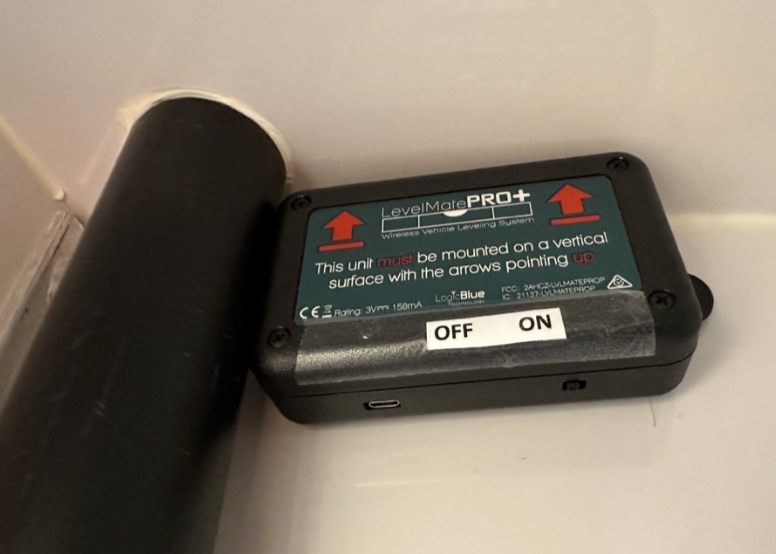
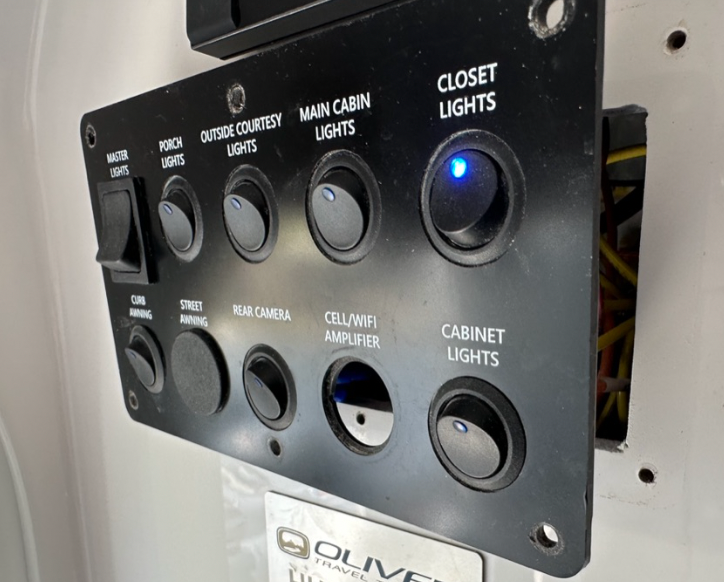
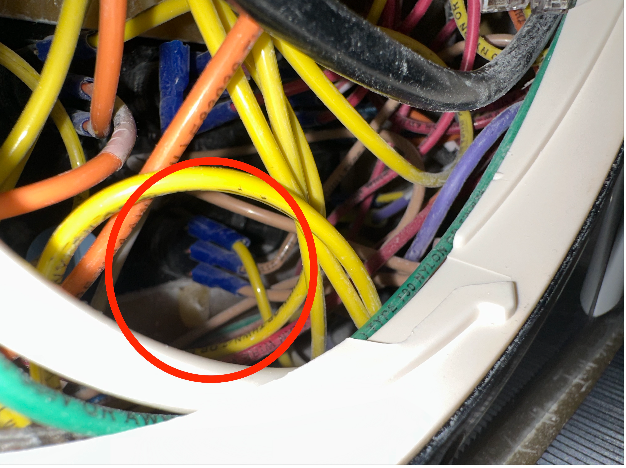
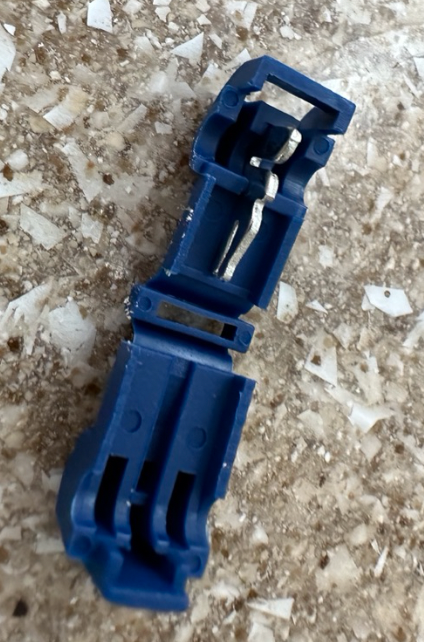
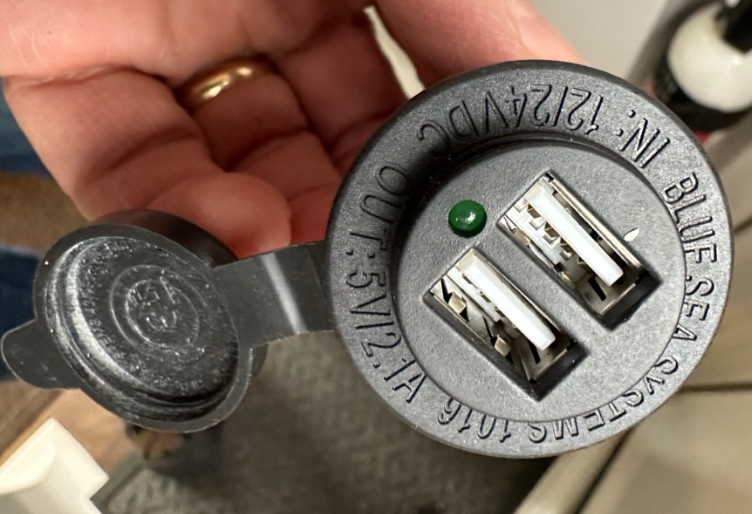
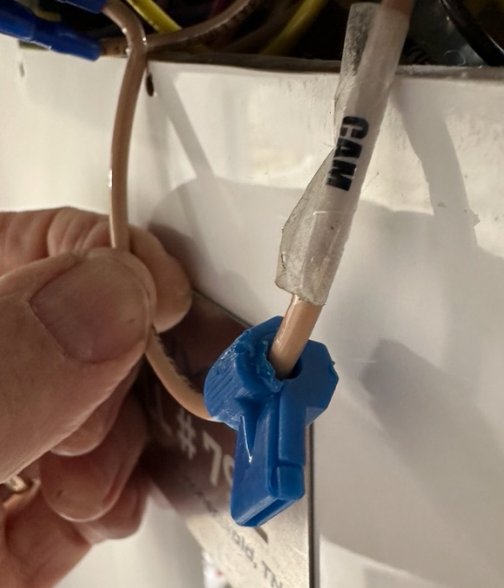
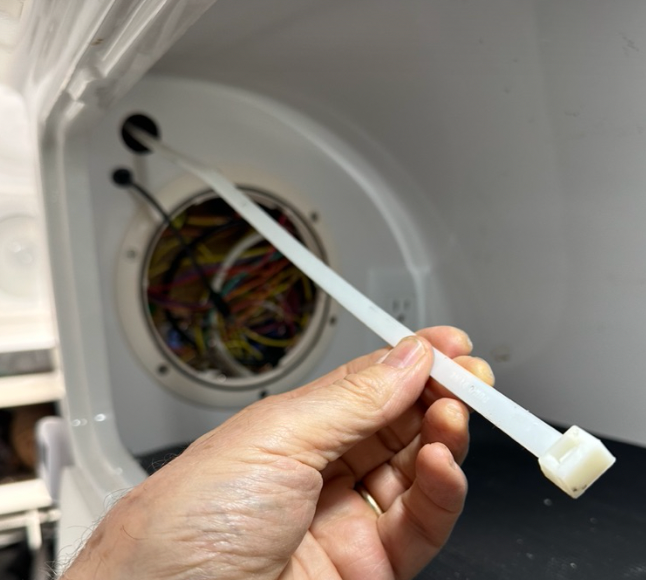
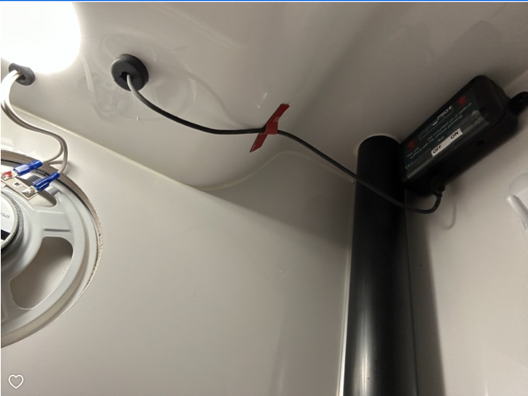
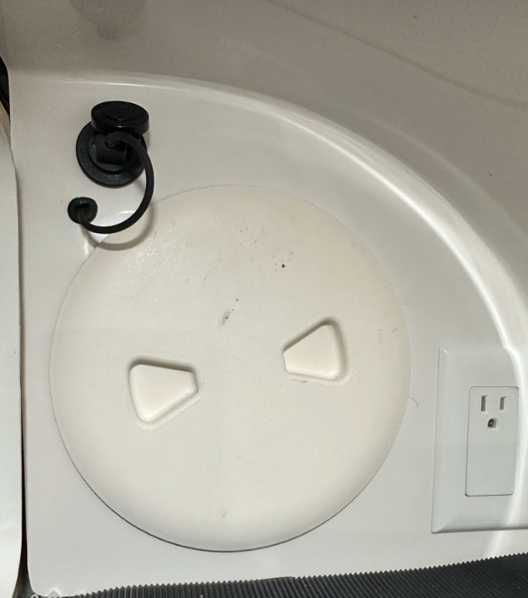


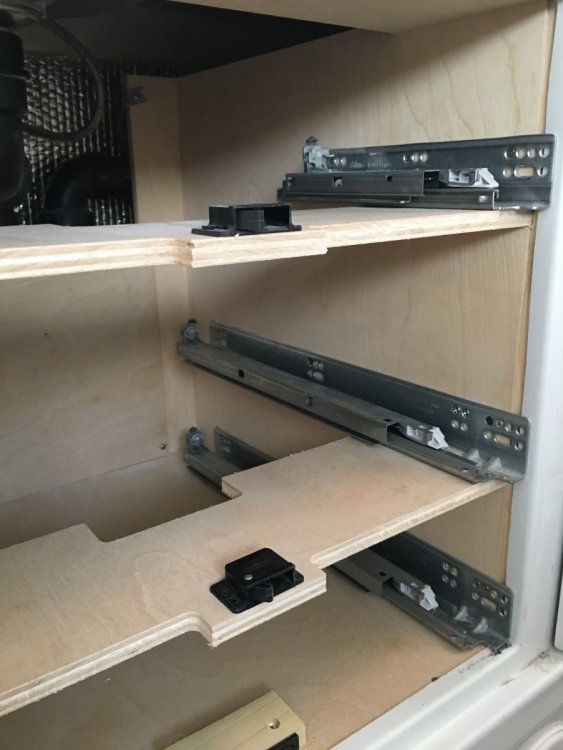

.thumb.jpeg.e2c5196e407624f32f90fd2d76b0b3e3.jpeg)
.thumb.jpeg.85bac82480da2288dc6c871450af91e4.jpeg)
